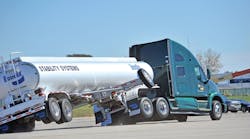Onboard safety systems can be vital tools in ongoing efforts by fleets and drivers to operate more safely and efficiently, helping them take better care of their vehicles by potentially preventing crashes and, in some cases, reducing equipment wear and tear, notes TJ Thomas, director of marketing and customer solutions - Controls group, Bendix Commercial Vehicle Systems (www.bendix.com).
Bendix develops and supplies leading-edge active safety technologies, energy management solutions and air brake charging and control systems and components under the Bendix brand name for medium and heavy duty trucks, tractors, trailers, buses and other commercial vehicles throughout North America.
Four key examples of systems growing in popularity, Thomas says, are full-stability, collision mitigation, lane departure warning and tire pressure monitoring. The technologies can be utilized independently, as well as in conjunction with systems that bring their data together.
- Full-stability systems. Also generically known as electronic stability control (ESC), these systems use a series of sensors to address a tractor’s roll and directional stability. Setting ESC apart from roll-only stability (RSC) systems are additional sensors that measure driver intent and vehicle direction.
“This means that full-stability systems recognize and potentially help the driver mitigate conditions that could lead to rollover and loss-of-control situations sooner on dry surfaces, and function in a wider range of driving and road conditions, including snowy, ice-covered and slippery surfaces,” he points out. “When necessary, full-stability systems offer automatic brake interventions involving the steer, drive, and trailer axles.”
- Collision mitigation technology. Built on the foundation of ESC, these systems use a radar sensor mounted to the front of the vehicle to deliver both warnings and active interventions that can help drivers potentially avoid rear-end collisions or at least help reduce their severity.
“Collision mitigation systems can provide distance and stationary object alerts and braking interventions, delivering up to two-thirds of the vehicle braking power through the steer, drive and trailer brakes,” says Thomas.
- Lane departure warning (LDW) technology. This pairs a forward-facing camera with an onboard computer that uses image recognition software to track visible lane markings. These systems continually monitor a vehicle’s position and can detect when the vehicle begins to drift toward an unintended lane change.
“Upon detection, an LDW system will emit a distinctive ‘rumble strip’ or other audible warning to alert the driver to make a correction.”
- Tire pressure monitoring system (TPMS). TPMS provides real-time tire status information - such as pressure and internal temperature—to drivers and maintenance technicians through wheel-end sensors.
“A TPMS provides alerts that tell the driver a particular tire is very low on pressure or very high in temperature,” adds Thomas. “Both alerts and data can be delivered to drivers through in-vehicle displays or an integrated OEM dashboard.
“By helping maintain properly inflated tires, a TPMS enhances vehicle safety, extends tire life, and improves fuel economy.”
DATA COMPILATION
Thomas explains that the complete data compiled by these four systems, including video recording in some cases, is invaluable to fleets, which can make the best use of the information by accessing it through a single portal.
SafetyDirect from Bendix CVS is one example of a user-friendly Web portal that provides fleet operators with comprehensive information on their fleet and each driver’s performance. The fleet’s analysis of this data aids in developing targeted, ongoing driver education and training.
In the case of SafetyDirect, the portal also keeps up with advancements in Bendix’s safety technologies.
An October 2013 report by the Federal Motor Carrier Safety Administration found that commercial drivers and fleet safety managers utilizing onboard safety systems generally say they are beneficial and increase safety, he points out.
“Both drivers and carrier staff recognized the relationship between safety, job retention and company reputation,” the report stated, notes Thomas, “[and] they appreciated how the OBSSs [onboard safety systems] reflected their company’s safety culture.”




